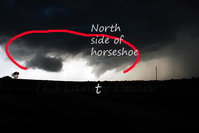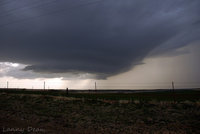Austin Jones
EF1
Looking back over my own learning curve, I want to address something that I feel could pose a threat to beginners, with little or no field experience. Without experience, I think it is too easy to accept hard rules about storm structure. For example text book examples of supercell storms, tell us the rain exists in the FFD, while the tornado exists under the rain free base, near the RFD. In the field however storms can be messy and have characteristics unique to themselves. HP storms can have RFDs full of rain that wraps the tornado and hides it. There was a time , when looking at pictures of HP storms I would mistake the RFD and mesocyclone area of the storm as the FFD, simply because there was a rain shaft below. For example, at one time I would have mistaken the picture attached to be of the FFD, and expected the tornadic region to be off screen somewhere to the left, south or behind of the feature pictured. This is of course wrong and in the field this mistake could lead a beginner into bad positioning and result in missing a tornado or worse finding one accidently.
While I never chased an HP storm as a beginner, during one of my first chases on a tornado warned storm I was completely lost because the rotation was on the leading edge of a QLCS. At the time I didn't even know what a QLCS was, but I "knew" tornadoes and rotation occur on the back of storms. Lack of knowledge of storm modes alternative to classic super cells, along with blind acceptance of "rules" left me very confused and with no situational awareness at the time. My advice to other beginners is to learn about all severe storm modes, chase with someone with some experience, and give dangerous storms lots of space at least until you are really sure of what you are looking at.
While I never chased an HP storm as a beginner, during one of my first chases on a tornado warned storm I was completely lost because the rotation was on the leading edge of a QLCS. At the time I didn't even know what a QLCS was, but I "knew" tornadoes and rotation occur on the back of storms. Lack of knowledge of storm modes alternative to classic super cells, along with blind acceptance of "rules" left me very confused and with no situational awareness at the time. My advice to other beginners is to learn about all severe storm modes, chase with someone with some experience, and give dangerous storms lots of space at least until you are really sure of what you are looking at.








